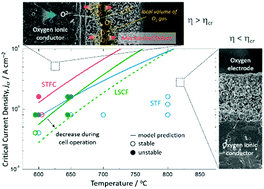Conditions for stable operation of solid oxide electrolysis cells: oxygen electrode effects†
Abstract
Solid oxide electrolysis cells (SOECs) convert renewable electricity to fuels with efficiency substantially higher than other electrolysis technologies. However, questions remain regarding degradation mechanisms that limit SOEC long-term stability. One of the key degradation mechanisms is oxygen electrode delamination; although prior studies have improved the understanding of this mechanism, it is still difficult to predict how degradation depends on SOEC materials and operating conditions, i.e., temperature, voltage, and current density. Here we present a study aimed at developing a quantitative understanding of oxygen electrode delamination. Experimentally, a life test study of symmetric and full cells with yttria-stabilized zirconia (YSZ) electrolytes and Gd-doped ceria (GDC) barrier layers was done with three different perovskite oxygen electrode materials. Fracture was observed at the perovskite–GDC interface above a critical current density and below a critical operating temperature. A theory is presented that combines a calculation of the effective oxygen pressure across the electrolyte with an estimation of the pressure required for fracture. Fracture is correctly predicted for a critical oxygen partial pressure of ∼7200 atm and an associated electrode overpotential of ∼0.2 V, occurring at the electrode/GDC interface because of the relatively low perovskite fracture toughness. Damage at the GDC/YSZ interface was also observed in some cases and explained by a peak in the oxygen pressure at this interface.



 Please wait while we load your content...
Please wait while we load your content...
